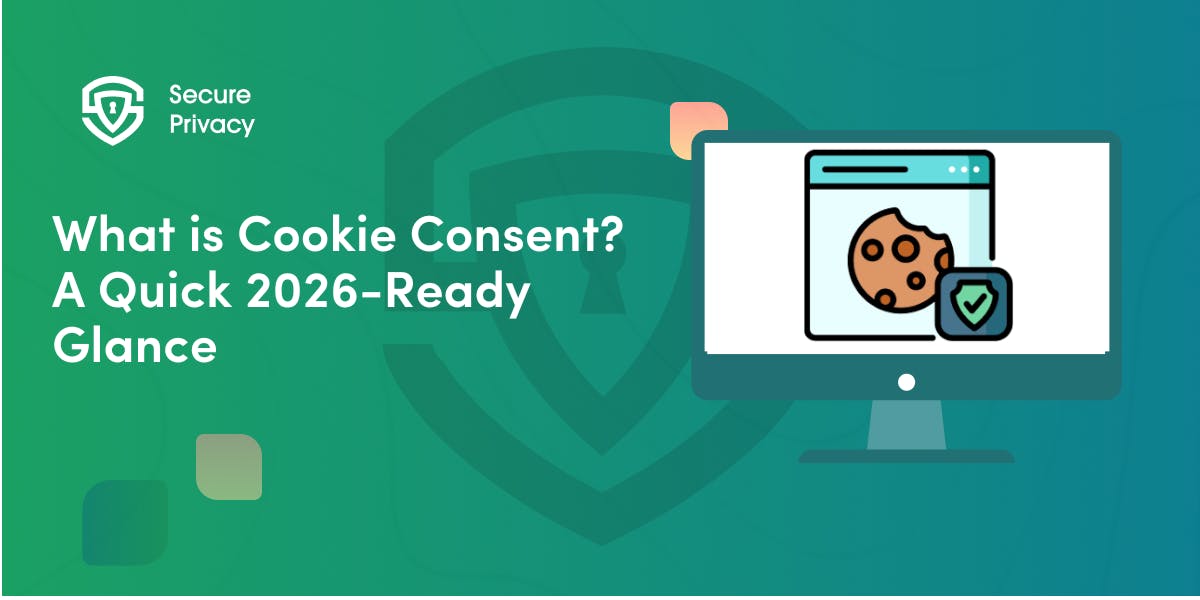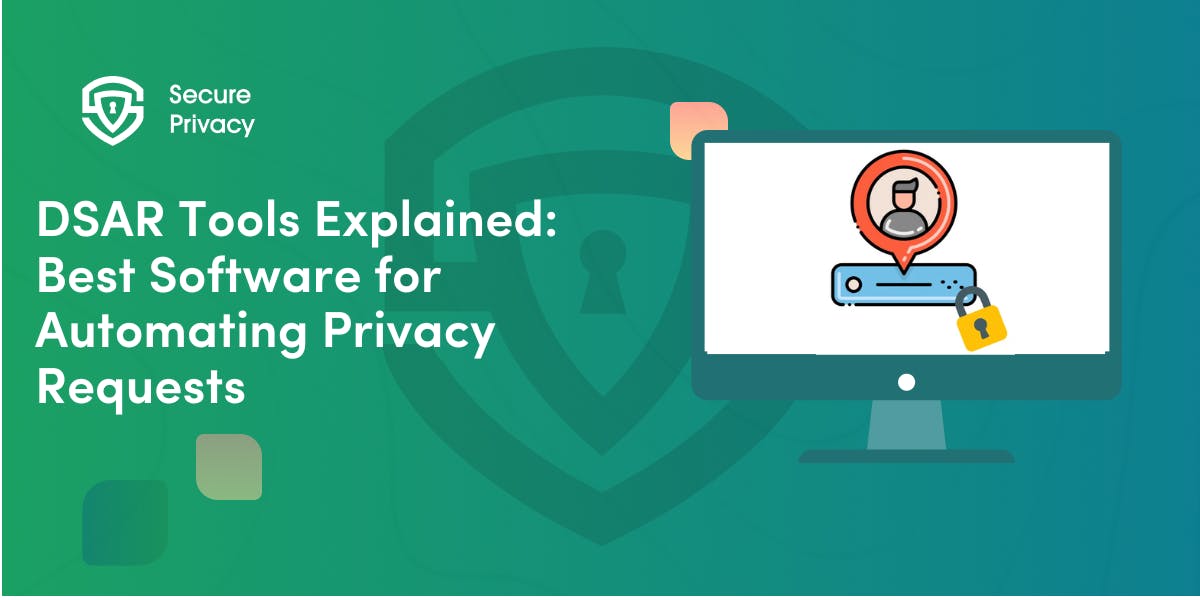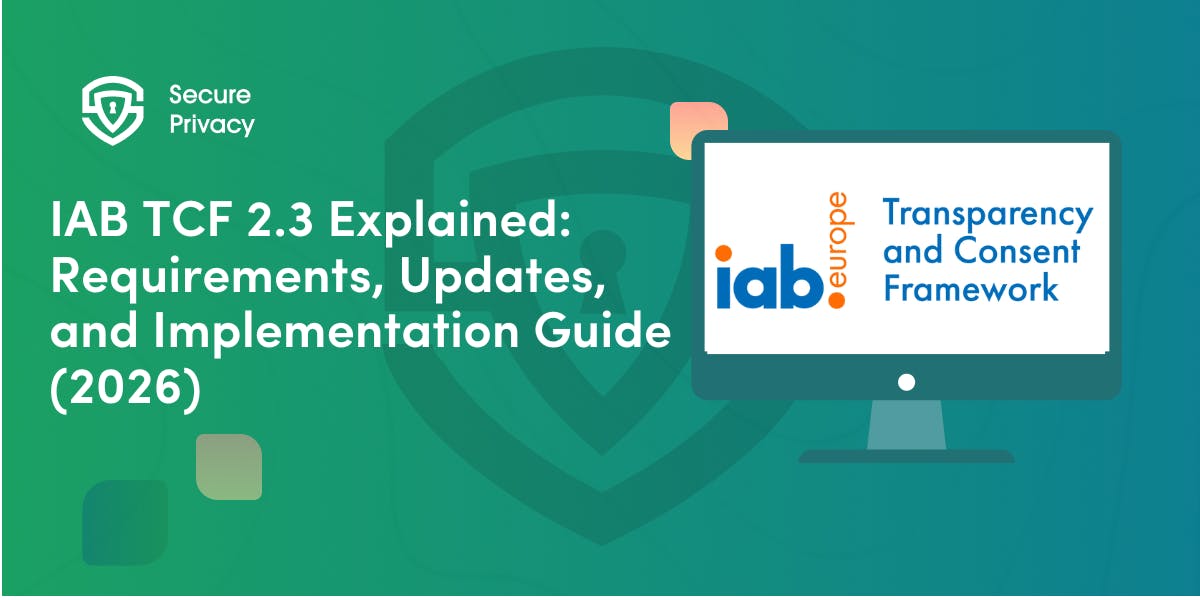How to Add GDPR to Website: Complete Implementation Guide
Your website collects visitor data every day — email addresses from newsletter signups, location data from analytics, behavioral tracking from ad pixels. If any of those visitors come from the European Union, you're subject to GDPR whether you realize it or not.
The penalty for non-compliance can reach €20 million or 4% of global annual revenue, whichever is higher. Beyond avoiding fines, adding GDPR to your website builds user trust, improves data quality, and positions your business as privacy-forward in today's regulation-heavy digital environment.
This guide shows you exactly how to add GDPR compliance to your website, from implementing effective cookie consent banners to updating privacy policies and choosing the right compliance tools.

Prioritizing user privacy is essential. Secure Privacy's free Privacy by Design Checklist helps you integrate privacy considerations into your development and data management processes.
Understanding GDPR Requirements for Websites
GDPR creates specific obligations for any website that processes personal data of EU residents. Personal data includes obvious identifiers like names and email addresses, but also extends to IP addresses, cookie identifiers, and behavioral tracking data that can single out individuals.
The regulation applies regardless of where your business operates—if you serve EU visitors, you must comply with GDPR. This extraterritorial reach means even small businesses without European offices must follow these rules when processing EU resident data.
Lawful Basis for Data Processing: Every piece of data you collect needs a valid legal basis under GDPR Article 6. For most marketing and analytics purposes, that basis is explicit user consent. Consent must be freely given, specific, informed, and unambiguous—pre-checked boxes and implied agreement don't meet the standard.
You cannot make website access conditional on consent for non-essential processing. Users must be able to access your content even if they decline marketing cookies, though you can offer enhanced features to consenting users. (Learn how to integrate GDPR with Privacy by Design principles.)
Cookie Consent Requirements: Before setting any non-essential cookies or tracking scripts, you must obtain prior consent. This means blocking analytics, advertising, and marketing cookies until users explicitly opt in. Essential cookies for basic site functionality can load without consent, but everything else requires permission.
Privacy Policy Transparency: Your privacy policy must clearly explain what data you collect, why you collect it, how long you keep it, and who gets access. The policy needs to accurately reflect your actual data practices, including third-party integrations and data transfers outside the EU.
Data Subject Rights: Website visitors have specific rights including access to their data, correction of inaccuracies, deletion, data portability, and objection to processing. You need mechanisms for users to exercise these rights efficiently through contact forms or dedicated request portals.
Security Measures: Protecting personal data requires appropriate technical safeguards including HTTPS encryption, access controls, and regular security assessments. Data minimization principles also apply—collect only what you genuinely need and retain it only as long as necessary for the stated purpose.
Step-by-Step: Adding GDPR Compliance to Your Website
Step 1: Conduct a Data Audit
Before implementing compliance tools, map exactly what data your website currently collects. Review form submissions, analytics configurations, advertising pixels, third-party integrations, and user account systems. Document the purpose for each data collection point, where that data gets stored, who has access, and retention periods.
This audit reveals compliance gaps and helps determine appropriate legal bases for data processing.
Step 2: Implement a Cookie Consent Banner
Modern consent management platforms automatically scan your website for cookies and tracking technologies, categorize them by purpose (essential, analytics, marketing, preferences), and inject blocking code that prevents non-essential cookies from loading until users opt in. The banner must offer equal prominence to "Accept All" and "Reject All" options without manipulative design patterns.
The technical implementation typically involves adding a JavaScript snippet to your website header. Quality consent management platforms integrate with popular website builders (WordPress, Shopify, Wix) through plugins that simplify installation.
Key Banner Elements:
- Clear, concise language explaining cookie use
- Granular controls allowing category-specific consent
- Easy withdrawal mechanism accessible from any page
- Mobile-responsive design that doesn't block content
Step 3: Update Your Privacy Policy
Your privacy policy serves as the primary disclosure document explaining data practices to users. List all personal data your website collects, including both direct inputs (contact forms, account creation) and indirect collection (cookies, analytics, IP addresses).
For each data type, specify the legal basis for processing, the purpose of collection, retention period, and any third parties receiving access. If you transfer data outside the EU, explain the safeguards used to protect that data, such as Standard Contractual Clauses or adequacy decisions.
Address data subject rights explicitly, providing clear instructions for users to access, correct, delete, or port their data. Include contact information for your data protection officer or privacy team, or at minimum, a dedicated privacy contact email.
Free privacy policy generators from platforms like Secure Privacy provide customizable templates covering GDPR requirements. These tools ask questions about your data practices and generate compliant policies automatically, though review by legal counsel ensures accuracy for complex situations.
Step 4: Integrate Consent with Analytics and Marketing Tools
Google Analytics, Facebook Pixel, advertising platforms, and marketing automation tools all set cookies that require user consent. Simply adding a consent banner isn't enough — you need to ensure these tools respect user choices.
Google Consent Mode v2 provides the current standard for integrating consent with Google's advertising and analytics ecosystem. Quality consent management platforms like Secure Privacy offer pre-built integrations that automatically control cookie behavior based on user consent status.
Step 5: Create Data Subject Request Procedures
Users exercising their GDPR rights need clear pathways to submit requests. At minimum, provide an email address or contact form specifically for privacy requests. Document your internal procedures for handling each request type within GDPR's 30-day response requirement.
Step 6: Document Everything
GDPR mandates detailed record-keeping demonstrating compliance. Your documentation should include:
- Complete inventory of data processing activities
- Consent records with timestamps showing exactly what users agreed to
- Privacy policy versions and update history
- Data subject request handling with resolution documentation
Consent management platforms automatically capture and store consent records with audit trails.
Best Practices for Website GDPR Compliance
Implement Granular Consent Controls: Rather than all-or-nothing consent, offer granular choices by cookie category. Users might accept analytics for site improvement while declining advertising and marketing cookies.
Maintain Transparent Data Practices: Transparency builds trust and satisfies GDPR's core principle that users should understand data handling. Go beyond generic privacy policy language to provide concrete examples of how you use data.
Create Comprehensive Audit Trails: Beyond recording consent, document all data processing activities and policy changes. These audit trails demonstrate good-faith compliance efforts and provide evidence during regulatory investigations.
Prioritize Accessibility and User Experience: Consent mechanisms shouldn't frustrate users or create barriers to website access. Design banner interfaces that work across devices, support keyboard navigation, and load quickly without blocking content.
Common GDPR Implementation Mistakes to Avoid
The "Accept All" Only Banner: Displaying a consent banner with only an "Accept All" button or making rejection significantly more difficult than acceptance violates GDPR consent requirements. Both acceptance and rejection must receive equal prominence.
Continuing Tracking Without Consent: Many websites display consent banners but fail to actually block cookies before users opt in. Proper implementation requires technical blocking of non-essential cookies until explicit user permission.
Ignoring Consent Across Domains: If your web presence spans multiple domains or subdomains, consent granted on one property doesn't automatically transfer to others. Quality consent platforms synchronize consent preferences across related domains.
Failing to Enable Consent Withdrawal: GDPR requires that withdrawing consent be as easy as granting it. Every page should include a persistent link to cookie preferences allowing instant consent modification.
Essential Tools for Website GDPR Compliance
Modern CMPs handle the technical complexity of GDPR compliance through automated cookie scanning, script blocking, consent collection, and documentation. Leading platforms include Secure Privacy, each offering comprehensive solutions with varying price points and feature sets.
When evaluating CMPs, prioritize these capabilities:
- Automatic cookie detection and categorization
- Technical blocking preventing non-consented tracking
- Pre-built integrations with major analytics and advertising platforms
- Google Consent Mode v2 support
- Customizable banner designs matching your brand
- Comprehensive audit trails and reporting
- Support for multiple regulatory frameworks (GDPR, CCPA, LGPD)
Regular audits identify compliance gaps before they become regulatory issues. Tools Secure Privacy examine cookie behavior, consent mechanisms, and privacy policy adequacy. Automated monitoring alerts you when new cookies appear on your website, when consent rates drop significantly, or when technical issues prevent proper consent collection.
Why Website GDPR Setup Protects Your Business
Beyond avoiding regulatory penalties, GDPR compliance delivers strategic advantages that justify the implementation investment.
Trust and Brand Reputation: Privacy-conscious consumers increasingly evaluate how businesses handle data. Transparent, user-friendly consent mechanisms signal respect for customer autonomy and build trust that translates to higher conversion rates and customer loyalty.
Data Quality Improvements: Collecting data only with explicit consent typically reduces volume but dramatically improves quality. Users who actively opt in engage more authentically and show higher lifetime value.
Reduced Legal and Financial Risk: Proactive compliance eliminates penalty risk while avoiding expensive emergency remediation that follows regulatory enforcement actions.
Simplify Website GDPR Setup with Secure Privacy
Secure Privacy provides comprehensive consent management designed specifically for website GDPR compliance. Our platform handles everything from initial cookie scanning and banner implementation to ongoing monitoring and compliance reporting.
What makes Secure Privacy the smart choice:
- Automated cookie detection continuously monitors your website for tracking technologies requiring consent
- One-click Google Consent Mode v2 integration ensures compliant analytics and advertising without custom development
- Pre-built templates for 50+ website platforms including WordPress, Shopify, Wix, Squarespace, and custom HTML sites
- Visual banner customization matching your brand without coding requirements
- Comprehensive audit trails capturing every consent interaction with timestamp and version documentation
- Multi-regulation support covering GDPR, CCPA, LGPD, and other global privacy frameworks
Secure Privacy customers achieve GDPR compliance in days rather than months, with ongoing automation reducing manual compliance work by up to 75%.
Start implementing website GDPR compliance today: Get a free website privacy scan to see exactly what cookies your site uses and which require consent, or start your free trial to implement complete GDPR compliance with Secure Privacy's automated platform. Website compliance starts with comprehensive bulk scanning.
Your website visitors deserve privacy protection that works. Your business deserves compliance tools that simplify rather than complicate. Secure Privacy delivers both.
Get Started For Free with the
#1 Cookie Consent Platform.
No credit card required

What is Cookie Consent? A Quick 2026-Ready Glance
Your website loads. Cookies track users. But without proper cookie consent, you're violating GDPR — risking fines up to €20 million or 4% of global revenue. Cookie consent is the legally required mechanism by which websites obtain explicit user approval before deploying non-essential tracking technologies. This requirement stems from GDPR Article 4(11) and the ePrivacy Directive, mandating that consent must be freely given, specific, informed, and unambiguous.
- Legal & News

DSAR Tools Explained: Best Software for Automating Privacy Requests
You're drowning in data subject access requests. Manual searches through dozens of systems miss regulatory deadlines and expose organizations to fines starting at $2,500 per violation. The solution? DSAR tools — purpose-built software that automates the entire process of responding to data subject access requests, from intake to delivery.
- Legal & News

IAB TCF 2.3 Explained: Requirements, Updates, and Implementation Guide (2026)
Your ad revenue dropped 40% overnight. Google stopped bidding on your inventory. Your DSP partners flagged your traffic as non-compliant. The culprit? An outdated TCF 2.2 consent string after the February 2026 enforcement deadline.
- Legal & News
- Cookie Consent
